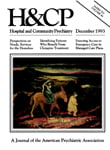Clozapine Treatment of Outpatients With Schizophrenia: Outcome and Long-Term Response Patterns
Abstract
The purpose of the study was to examine the effects of clozapine in treating moderately ill schizophrenic outpatients and to determine the length of medication trial needed to identify responders and nonresponders. Methods: Rates of clinical response, relapses and hospitalizations, and levels of symptomatology and functioning were assessed for 30 chronic schizophrenic outpatients who received clozapine for one year. For some patients, data on relapse and hospitalization during treatment were compared with data from the year before treatment. Results: Eighteen of the 30 patients met criteria for sustained response; 1 7 of the responders were identified within the first four months of treatment. Patients experienced significantly fewer relapses and hospitalizations during treatment than in the previous year. Improvement in positive symptoms, general symptomatology, and levels of functioning reached a plateau during the first six months of treatment and remained at that level during the second six months. Negative symptoms and quality of life showed nonsignificant improvements at 12 months. Conclusions: Results support the use of clozapine in treating chronic, residually symptomatic schizophrenic outpatients. A four-month clozapine trial may be adequate to detect clinical responders in this population.
Access content
To read the fulltext, please use one of the options below to sign in or purchase access.- Personal login
- Institutional Login
- Sign in via OpenAthens
- Register for access
-
Please login/register if you wish to pair your device and check access availability.
Not a subscriber?
PsychiatryOnline subscription options offer access to the DSM-5 library, books, journals, CME, and patient resources. This all-in-one virtual library provides psychiatrists and mental health professionals with key resources for diagnosis, treatment, research, and professional development.
Need more help? PsychiatryOnline Customer Service may be reached by emailing [email protected] or by calling 800-368-5777 (in the U.S.) or 703-907-7322 (outside the U.S.).



